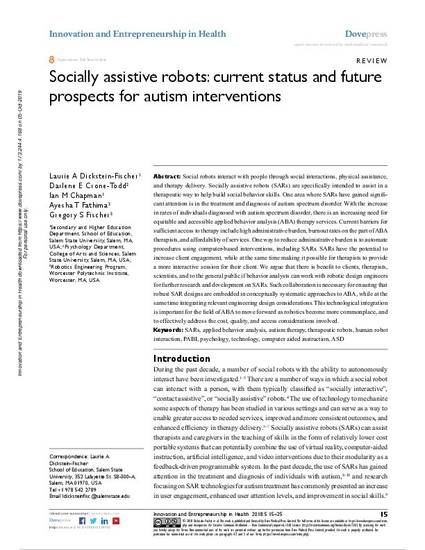
Article
Socially Assistive Robots: Current Status And Future Prospects For Autism Interventions
Innovation and Entrepreneurship in Health
(2016)
Abstract
Social robots interact with people through social interactions, physical assistance, and therapy delivery. Socially assistive robots (SARs) are specifically intended to assist in a therapeutic way to help build social behavior skills. One area where SARs have gained significant attention is in the treatment and diagnosis of autism spectrum disorder. With the increase in rates of individuals diagnosed with autism spectrum disorder, there is an increasing need for equitable and accessible applied behavior analysis (ABA) therapy services. Current barriers for sufficient access to therapy include high administrative burden, burnout rates on the part of ABA therapists, and affordability of services. One way to reduce administrative burden is to automate procedures using computer-based interventions, including SARs. SARs have the potential to increase client engagement, while at the same time making it possible for therapists to provide a more interactive session for their client. We argue that there is benefit to clients, therapists, scientists, and to the general public if behavior analysts can work with robotic design engineers for further research and development on SARs. Such collaboration is necessary for ensuring that robust SAR designs are embedded in conceptually systematic approaches to ABA, while at the same time integrating relevant engineering design considerations. This technological integration is important for the field of ABA to move forward as robotics become more commonplace, and to effectively address the cost, quality, and access considerations involved.
Keywords
- SARs,
- applied behavior analysis,
- autism therapy,
- therapeutic robots,
- human robot interaction,
- PABI,
- psychology,
- technology,
- computer aided instruction,
- ASD
Disciplines
Publication Date
June 14, 2016
DOI
10.2147/IEH.S138753
Citation Information
Darlene Crone-Todd, Laurie A. Dickstein-Fischer, Ian M. Chapman, Ayesha T. Fathima, et al.. "Socially Assistive Robots: Current Status And Future Prospects For Autism Interventions" Innovation and Entrepreneurship in Health Vol. 5 (2016) p. 15 - 25 Available at: http://works.bepress.com/darlene-cronetodd/16/
Creative Commons license

This work is licensed under a Creative Commons CC_BY-NC International License.
